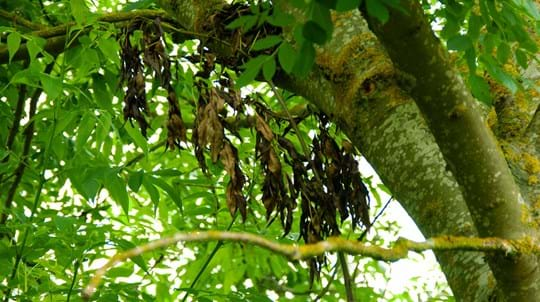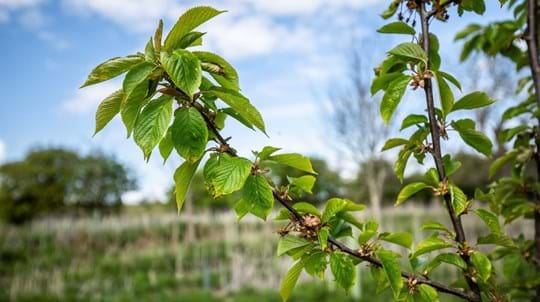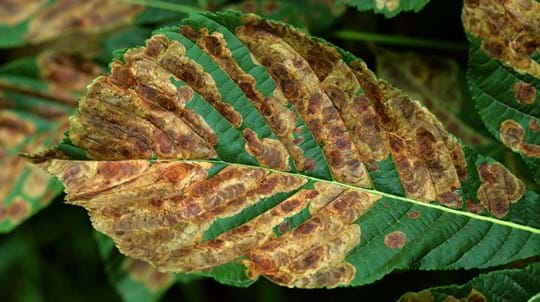
Where do our trees come from?
With increasing numbers of tree pests and diseases in the UK, it's important we have confidence in the trees we plant. Find out more about how our trees are sourced and grown.
More on where our trees come fromAs tree diseases and pests increasingly threaten our woods and trees, we are fighting back. We’re doing everything we can to prevent the spread and protect the UK’s trees.
Every year millions of potentially infected live trees, and tonnes of timber and wood packaging, are shipped into the UK.
One of the main ways that tree pests and diseases enter the UK is through imported trees and wood. Around £12bn of plants and plant commodities come into the UK each year.
Tree imports rose 700% from 1992 to 2019. This coincided with 267 non-native plant pests arriving and establishing themselves here. Ash dieback alone could kill 80% of UK ash trees at a predicted economic cost of £15bn.
Another 127 pests and diseases are considered high risk to the UK. If they reach our shores, 47 of them could cost over £1bn each to tackle.
We are committed to ensuring that we don’t import any new pests or diseases and that all the trees we plant are sourced and grown in the UK and Ireland.
Since 2014 we’ve grown and ordered over 16 million UK and Ireland sourced and grown trees which helps prevent the spread of tree diseases by reducing imports. This means every tree we plant or supply in our tree packs is fully traceable.
We also encourage other companies and suppliers that buy and plant trees to source responsibly, with disease-free supply chain for trees, timber-based products and packaging.

With increasing numbers of tree pests and diseases in the UK, it's important we have confidence in the trees we plant. Find out more about how our trees are sourced and grown.
More on where our trees come fromWe desperately need better ways of detecting threats when plants arrive in the UK, through training and the use of new technologies.
We lobby the government for more effective control over movement of plants in the UK to reduce the risk of spreading pests and diseases.
As outlined in our Tree Health Position Statement, we are pushing for new and improved UK biosecurity legislation. This should be focused on the prevention of introduction and movement of all unwanted organisms including pests, diseases and invasive species. We'd also like to see stricter quarantine and fewer points of entry so it's easier to enforce.
Always take notice of signage and avoid areas of woodland that may be affected by pests or diseases.
Tree pests and diseases aren’t always visible when they’re present. There are simple steps you can take to slow the spread of pests and diseases:

Disease decimated the UK's elms, and now another is wiping out our ash trees. But all is not lost - with replanting and tighter controls on tree imports, we can start to repair the damage.
Support the fundThe loss of trees in the countryside, fields, hedgerows, parks and roadsides poses huge threats to wildlife.
Trees and woods are vital components of our landscape. Sadly, much of our woodland has become fragmented over the years, and with the threat from tree pests and diseases now on the rise, it is critical to protect what is left.
Tree pests and diseases have the potential to cause significant gaps in our landscape. Planting alternative native trees when a certain species is in decline will help to make our landscape more resilient, and to help we offer advice and support on where to plant new native trees and why.
To spot and monitor tree health in the UK, we are working with partners and citizen scientists on a project known as Observatree.
Tree health professionals and trained volunteers look out for and report tree pest or disease sightings so that outbreaks can be prevented or controlled.

Observatree is a tree health early warning system ensuring that tree pests and diseases are spotted and reported quickly so they can be eliminated or controlled.
Find out more about ObservatreePlanting alternative native tree species can help to create more diverse landscapes in terms of numbers of species and structure.
From single trees to whole woodlands, creating a landscape that's diverse means that it's more likely to bounce back from the impacts of pests and diseases.

Shop
A mix of native trees future-proofs the landscape and helps it bounce back from pests and diseases. Buy your pack now.
External link

Plant trees
If you’re looking to plant trees, we have the trees, grants and funding schemes to help.

Trees woods and wildlife
A list of the most important pests and diseases threatening the UK's trees with top spotting tips.